Critical Essay: Deconstructing Aboriginal Health Question and Factors
VerifiedAdded on 2020/02/24
|7
|1569
|226
Essay
AI Summary
This essay critically examines the question of why Aboriginal people might appear uninterested in their own health, deconstructing the underlying assumptions and perspectives that shape this question. It delves into the historical context of colonization, the loss of land, and the ongoing impact of racism, including the removal of Aboriginal children and the resulting health disparities. The essay highlights barriers to healthcare access, such as cultural insensitivity, language barriers, the cost of services, and the distrust stemming from past experiences of discrimination within the healthcare system. It explores factors like institutional racism, lack of cultural safety, and social determinants of health, arguing that the perception of Aboriginal apathy towards health is a partial truth, influenced by a complex interplay of societal and systemic issues. The essay references various research studies to support its claims, emphasizing the need for a more nuanced understanding of the challenges faced by Aboriginal communities in accessing and engaging with healthcare services.
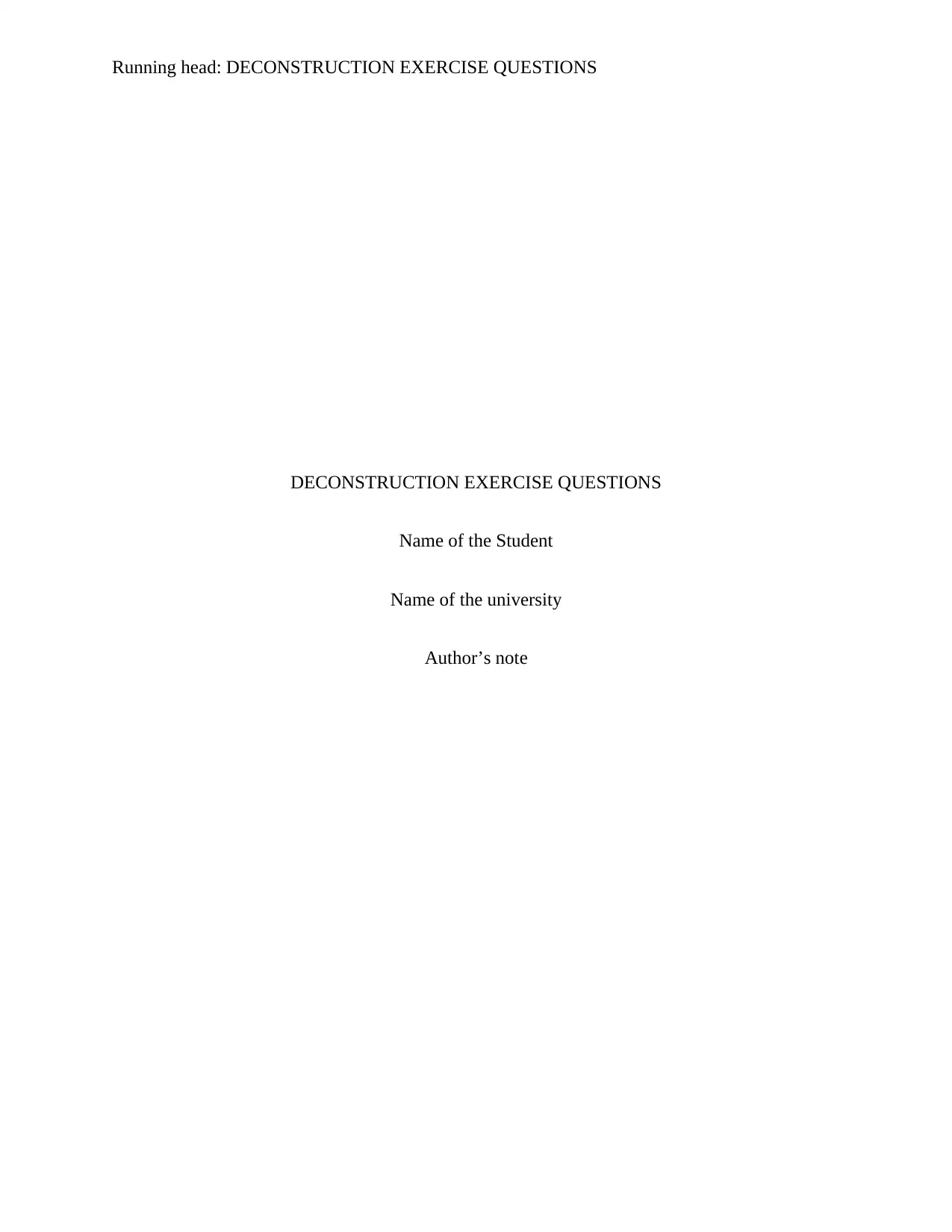
Running head: DECONSTRUCTION EXERCISE QUESTIONS
DECONSTRUCTION EXERCISE QUESTIONS
Name of the Student
Name of the university
Author’s note
DECONSTRUCTION EXERCISE QUESTIONS
Name of the Student
Name of the university
Author’s note
Paraphrase This Document
Need a fresh take? Get an instant paraphrase of this document with our AI Paraphraser
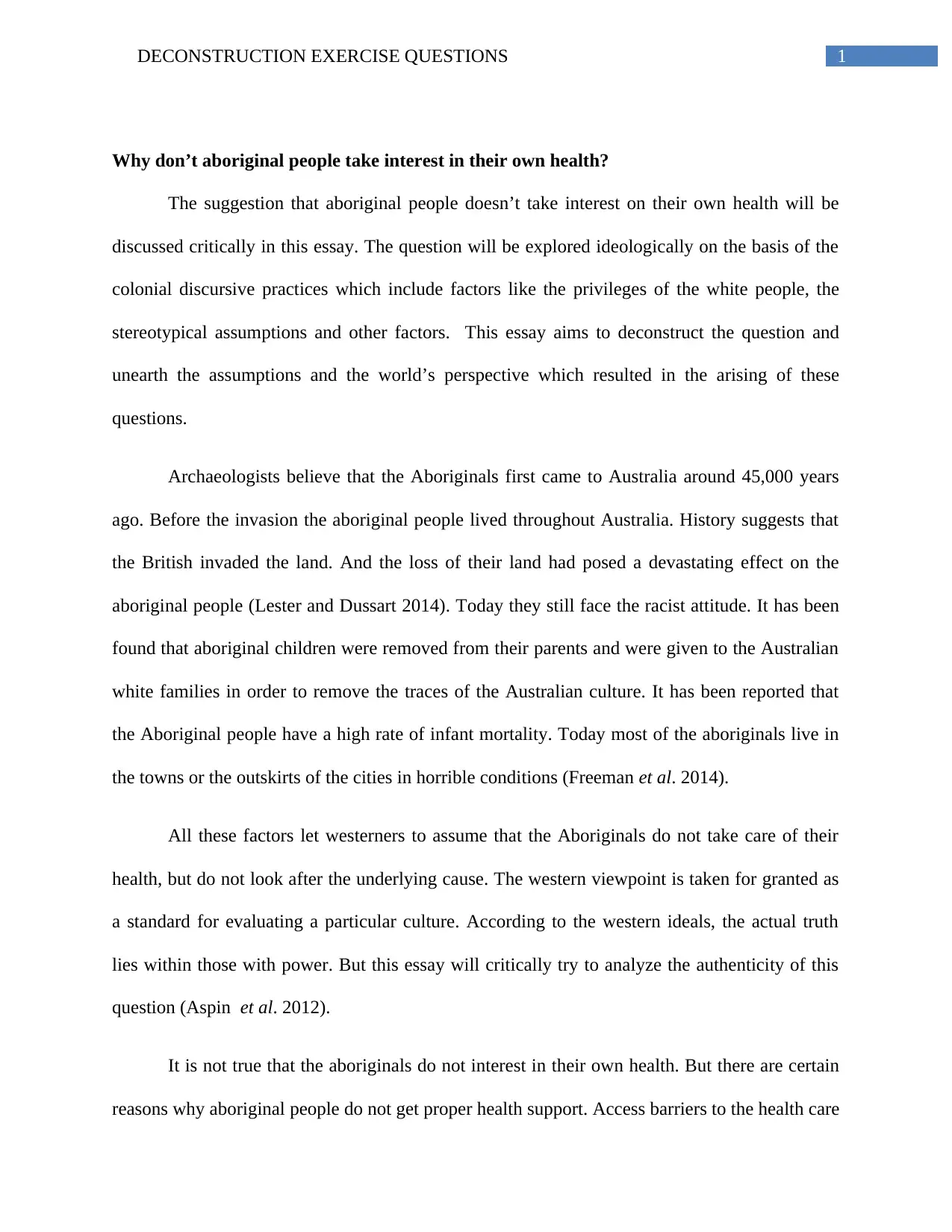
1DECONSTRUCTION EXERCISE QUESTIONS
Why don’t aboriginal people take interest in their own health?
The suggestion that aboriginal people doesn’t take interest on their own health will be
discussed critically in this essay. The question will be explored ideologically on the basis of the
colonial discursive practices which include factors like the privileges of the white people, the
stereotypical assumptions and other factors. This essay aims to deconstruct the question and
unearth the assumptions and the world’s perspective which resulted in the arising of these
questions.
Archaeologists believe that the Aboriginals first came to Australia around 45,000 years
ago. Before the invasion the aboriginal people lived throughout Australia. History suggests that
the British invaded the land. And the loss of their land had posed a devastating effect on the
aboriginal people (Lester and Dussart 2014). Today they still face the racist attitude. It has been
found that aboriginal children were removed from their parents and were given to the Australian
white families in order to remove the traces of the Australian culture. It has been reported that
the Aboriginal people have a high rate of infant mortality. Today most of the aboriginals live in
the towns or the outskirts of the cities in horrible conditions (Freeman et al. 2014).
All these factors let westerners to assume that the Aboriginals do not take care of their
health, but do not look after the underlying cause. The western viewpoint is taken for granted as
a standard for evaluating a particular culture. According to the western ideals, the actual truth
lies within those with power. But this essay will critically try to analyze the authenticity of this
question (Aspin et al. 2012).
It is not true that the aboriginals do not interest in their own health. But there are certain
reasons why aboriginal people do not get proper health support. Access barriers to the health care
Why don’t aboriginal people take interest in their own health?
The suggestion that aboriginal people doesn’t take interest on their own health will be
discussed critically in this essay. The question will be explored ideologically on the basis of the
colonial discursive practices which include factors like the privileges of the white people, the
stereotypical assumptions and other factors. This essay aims to deconstruct the question and
unearth the assumptions and the world’s perspective which resulted in the arising of these
questions.
Archaeologists believe that the Aboriginals first came to Australia around 45,000 years
ago. Before the invasion the aboriginal people lived throughout Australia. History suggests that
the British invaded the land. And the loss of their land had posed a devastating effect on the
aboriginal people (Lester and Dussart 2014). Today they still face the racist attitude. It has been
found that aboriginal children were removed from their parents and were given to the Australian
white families in order to remove the traces of the Australian culture. It has been reported that
the Aboriginal people have a high rate of infant mortality. Today most of the aboriginals live in
the towns or the outskirts of the cities in horrible conditions (Freeman et al. 2014).
All these factors let westerners to assume that the Aboriginals do not take care of their
health, but do not look after the underlying cause. The western viewpoint is taken for granted as
a standard for evaluating a particular culture. According to the western ideals, the actual truth
lies within those with power. But this essay will critically try to analyze the authenticity of this
question (Aspin et al. 2012).
It is not true that the aboriginals do not interest in their own health. But there are certain
reasons why aboriginal people do not get proper health support. Access barriers to the health care
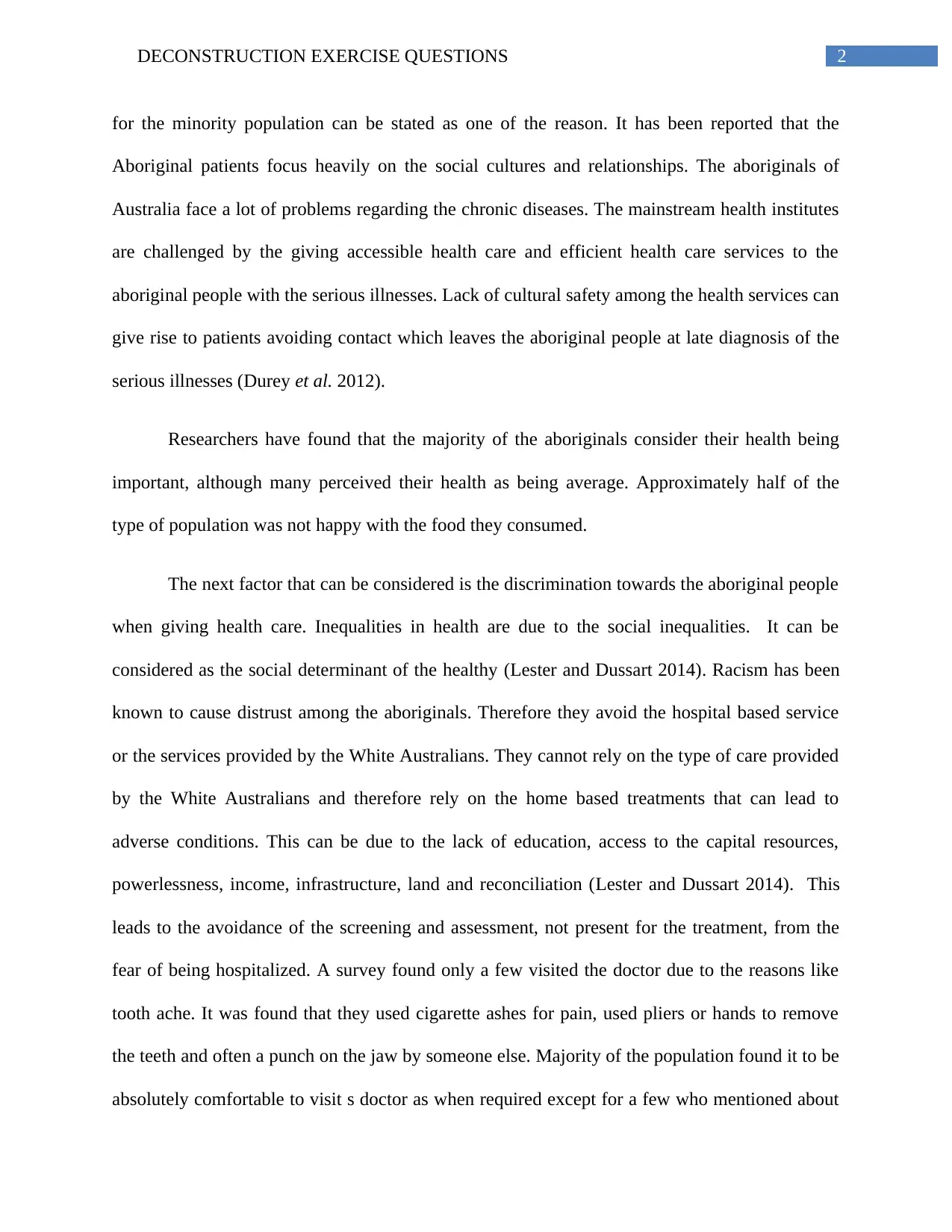
2DECONSTRUCTION EXERCISE QUESTIONS
for the minority population can be stated as one of the reason. It has been reported that the
Aboriginal patients focus heavily on the social cultures and relationships. The aboriginals of
Australia face a lot of problems regarding the chronic diseases. The mainstream health institutes
are challenged by the giving accessible health care and efficient health care services to the
aboriginal people with the serious illnesses. Lack of cultural safety among the health services can
give rise to patients avoiding contact which leaves the aboriginal people at late diagnosis of the
serious illnesses (Durey et al. 2012).
Researchers have found that the majority of the aboriginals consider their health being
important, although many perceived their health as being average. Approximately half of the
type of population was not happy with the food they consumed.
The next factor that can be considered is the discrimination towards the aboriginal people
when giving health care. Inequalities in health are due to the social inequalities. It can be
considered as the social determinant of the healthy (Lester and Dussart 2014). Racism has been
known to cause distrust among the aboriginals. Therefore they avoid the hospital based service
or the services provided by the White Australians. They cannot rely on the type of care provided
by the White Australians and therefore rely on the home based treatments that can lead to
adverse conditions. This can be due to the lack of education, access to the capital resources,
powerlessness, income, infrastructure, land and reconciliation (Lester and Dussart 2014). This
leads to the avoidance of the screening and assessment, not present for the treatment, from the
fear of being hospitalized. A survey found only a few visited the doctor due to the reasons like
tooth ache. It was found that they used cigarette ashes for pain, used pliers or hands to remove
the teeth and often a punch on the jaw by someone else. Majority of the population found it to be
absolutely comfortable to visit s doctor as when required except for a few who mentioned about
for the minority population can be stated as one of the reason. It has been reported that the
Aboriginal patients focus heavily on the social cultures and relationships. The aboriginals of
Australia face a lot of problems regarding the chronic diseases. The mainstream health institutes
are challenged by the giving accessible health care and efficient health care services to the
aboriginal people with the serious illnesses. Lack of cultural safety among the health services can
give rise to patients avoiding contact which leaves the aboriginal people at late diagnosis of the
serious illnesses (Durey et al. 2012).
Researchers have found that the majority of the aboriginals consider their health being
important, although many perceived their health as being average. Approximately half of the
type of population was not happy with the food they consumed.
The next factor that can be considered is the discrimination towards the aboriginal people
when giving health care. Inequalities in health are due to the social inequalities. It can be
considered as the social determinant of the healthy (Lester and Dussart 2014). Racism has been
known to cause distrust among the aboriginals. Therefore they avoid the hospital based service
or the services provided by the White Australians. They cannot rely on the type of care provided
by the White Australians and therefore rely on the home based treatments that can lead to
adverse conditions. This can be due to the lack of education, access to the capital resources,
powerlessness, income, infrastructure, land and reconciliation (Lester and Dussart 2014). This
leads to the avoidance of the screening and assessment, not present for the treatment, from the
fear of being hospitalized. A survey found only a few visited the doctor due to the reasons like
tooth ache. It was found that they used cigarette ashes for pain, used pliers or hands to remove
the teeth and often a punch on the jaw by someone else. Majority of the population found it to be
absolutely comfortable to visit s doctor as when required except for a few who mentioned about
⊘ This is a preview!⊘
Do you want full access?
Subscribe today to unlock all pages.

Trusted by 1+ million students worldwide
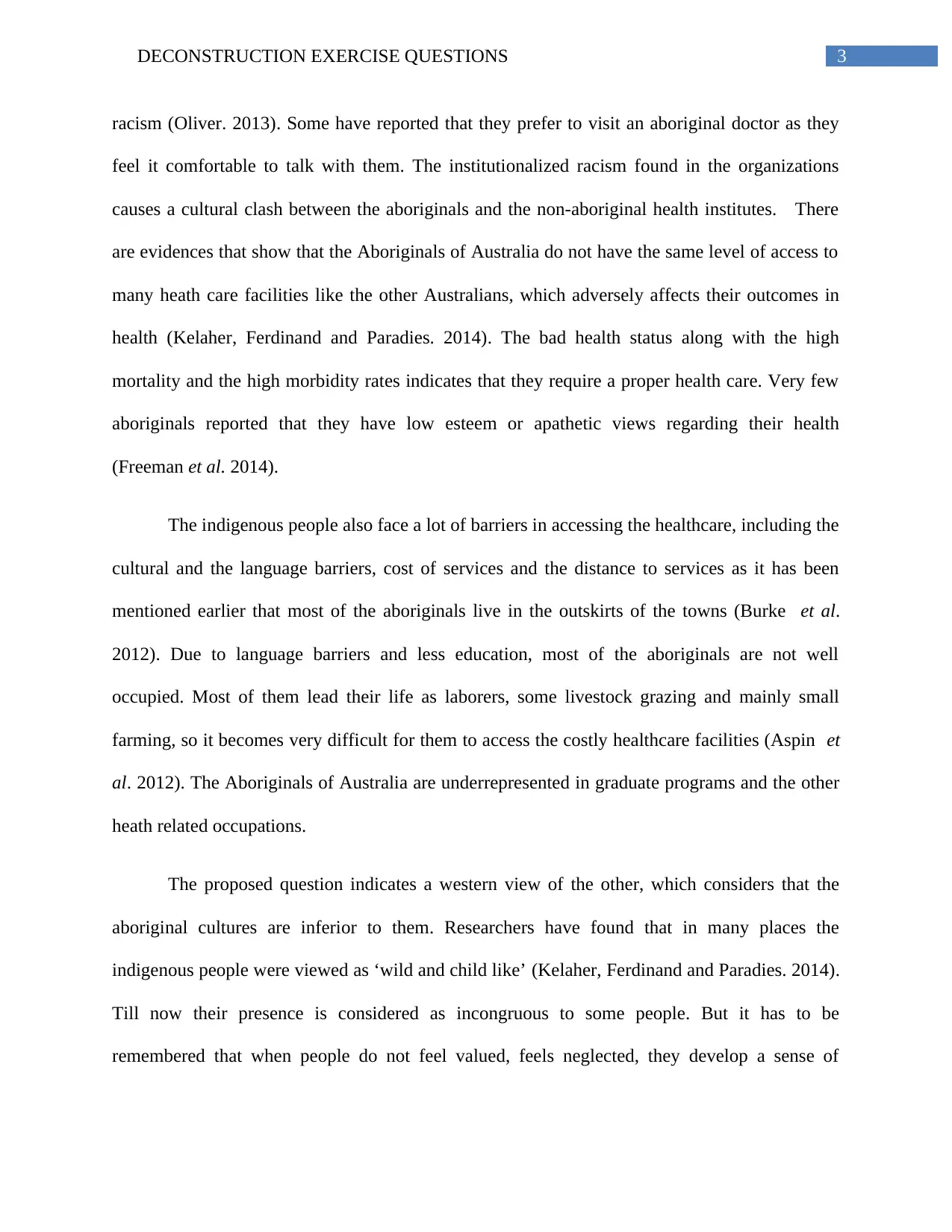
3DECONSTRUCTION EXERCISE QUESTIONS
racism (Oliver. 2013). Some have reported that they prefer to visit an aboriginal doctor as they
feel it comfortable to talk with them. The institutionalized racism found in the organizations
causes a cultural clash between the aboriginals and the non-aboriginal health institutes. There
are evidences that show that the Aboriginals of Australia do not have the same level of access to
many heath care facilities like the other Australians, which adversely affects their outcomes in
health (Kelaher, Ferdinand and Paradies. 2014). The bad health status along with the high
mortality and the high morbidity rates indicates that they require a proper health care. Very few
aboriginals reported that they have low esteem or apathetic views regarding their health
(Freeman et al. 2014).
The indigenous people also face a lot of barriers in accessing the healthcare, including the
cultural and the language barriers, cost of services and the distance to services as it has been
mentioned earlier that most of the aboriginals live in the outskirts of the towns (Burke et al.
2012). Due to language barriers and less education, most of the aboriginals are not well
occupied. Most of them lead their life as laborers, some livestock grazing and mainly small
farming, so it becomes very difficult for them to access the costly healthcare facilities (Aspin et
al. 2012). The Aboriginals of Australia are underrepresented in graduate programs and the other
heath related occupations.
The proposed question indicates a western view of the other, which considers that the
aboriginal cultures are inferior to them. Researchers have found that in many places the
indigenous people were viewed as ‘wild and child like’ (Kelaher, Ferdinand and Paradies. 2014).
Till now their presence is considered as incongruous to some people. But it has to be
remembered that when people do not feel valued, feels neglected, they develop a sense of
racism (Oliver. 2013). Some have reported that they prefer to visit an aboriginal doctor as they
feel it comfortable to talk with them. The institutionalized racism found in the organizations
causes a cultural clash between the aboriginals and the non-aboriginal health institutes. There
are evidences that show that the Aboriginals of Australia do not have the same level of access to
many heath care facilities like the other Australians, which adversely affects their outcomes in
health (Kelaher, Ferdinand and Paradies. 2014). The bad health status along with the high
mortality and the high morbidity rates indicates that they require a proper health care. Very few
aboriginals reported that they have low esteem or apathetic views regarding their health
(Freeman et al. 2014).
The indigenous people also face a lot of barriers in accessing the healthcare, including the
cultural and the language barriers, cost of services and the distance to services as it has been
mentioned earlier that most of the aboriginals live in the outskirts of the towns (Burke et al.
2012). Due to language barriers and less education, most of the aboriginals are not well
occupied. Most of them lead their life as laborers, some livestock grazing and mainly small
farming, so it becomes very difficult for them to access the costly healthcare facilities (Aspin et
al. 2012). The Aboriginals of Australia are underrepresented in graduate programs and the other
heath related occupations.
The proposed question indicates a western view of the other, which considers that the
aboriginal cultures are inferior to them. Researchers have found that in many places the
indigenous people were viewed as ‘wild and child like’ (Kelaher, Ferdinand and Paradies. 2014).
Till now their presence is considered as incongruous to some people. But it has to be
remembered that when people do not feel valued, feels neglected, they develop a sense of
Paraphrase This Document
Need a fresh take? Get an instant paraphrase of this document with our AI Paraphraser
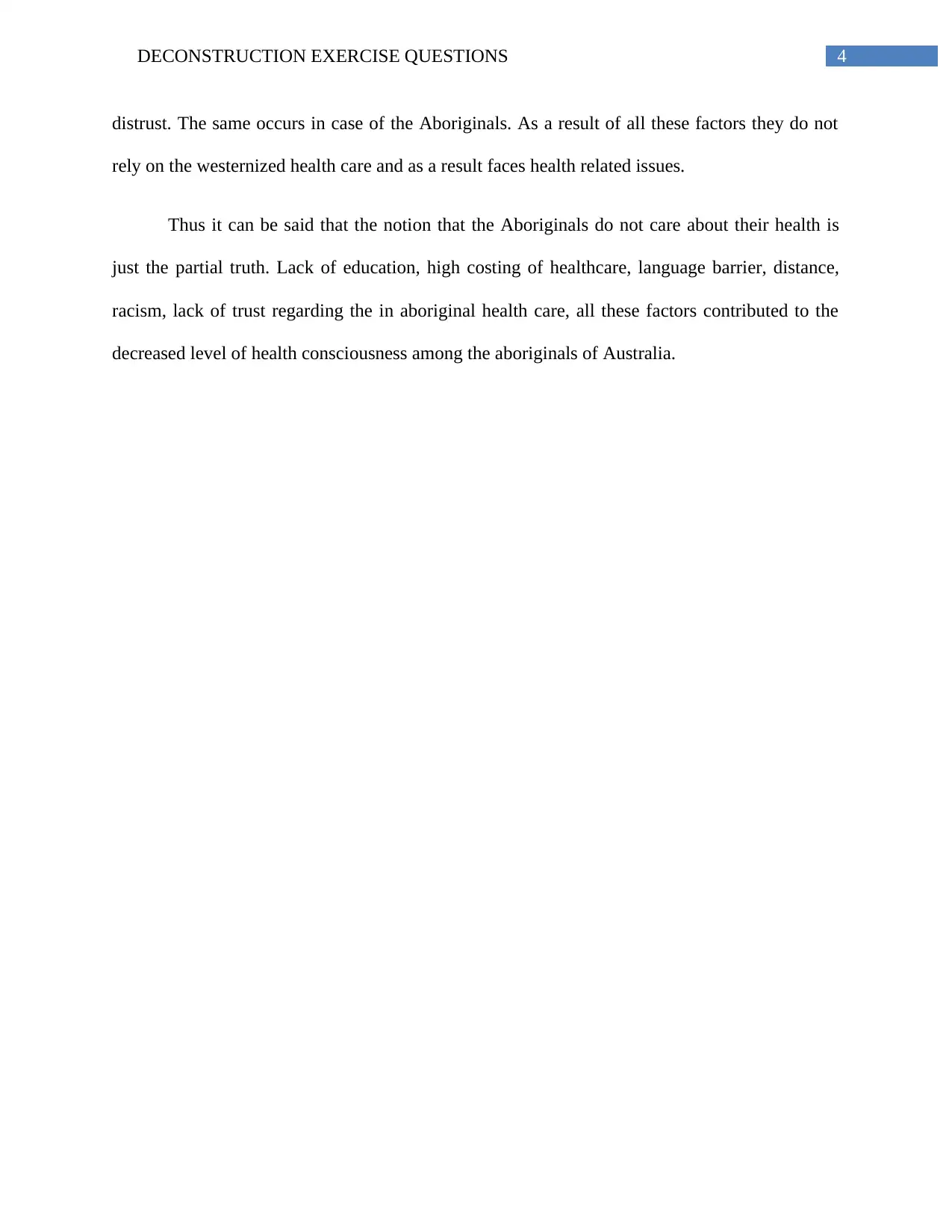
4DECONSTRUCTION EXERCISE QUESTIONS
distrust. The same occurs in case of the Aboriginals. As a result of all these factors they do not
rely on the westernized health care and as a result faces health related issues.
Thus it can be said that the notion that the Aboriginals do not care about their health is
just the partial truth. Lack of education, high costing of healthcare, language barrier, distance,
racism, lack of trust regarding the in aboriginal health care, all these factors contributed to the
decreased level of health consciousness among the aboriginals of Australia.
distrust. The same occurs in case of the Aboriginals. As a result of all these factors they do not
rely on the westernized health care and as a result faces health related issues.
Thus it can be said that the notion that the Aboriginals do not care about their health is
just the partial truth. Lack of education, high costing of healthcare, language barrier, distance,
racism, lack of trust regarding the in aboriginal health care, all these factors contributed to the
decreased level of health consciousness among the aboriginals of Australia.
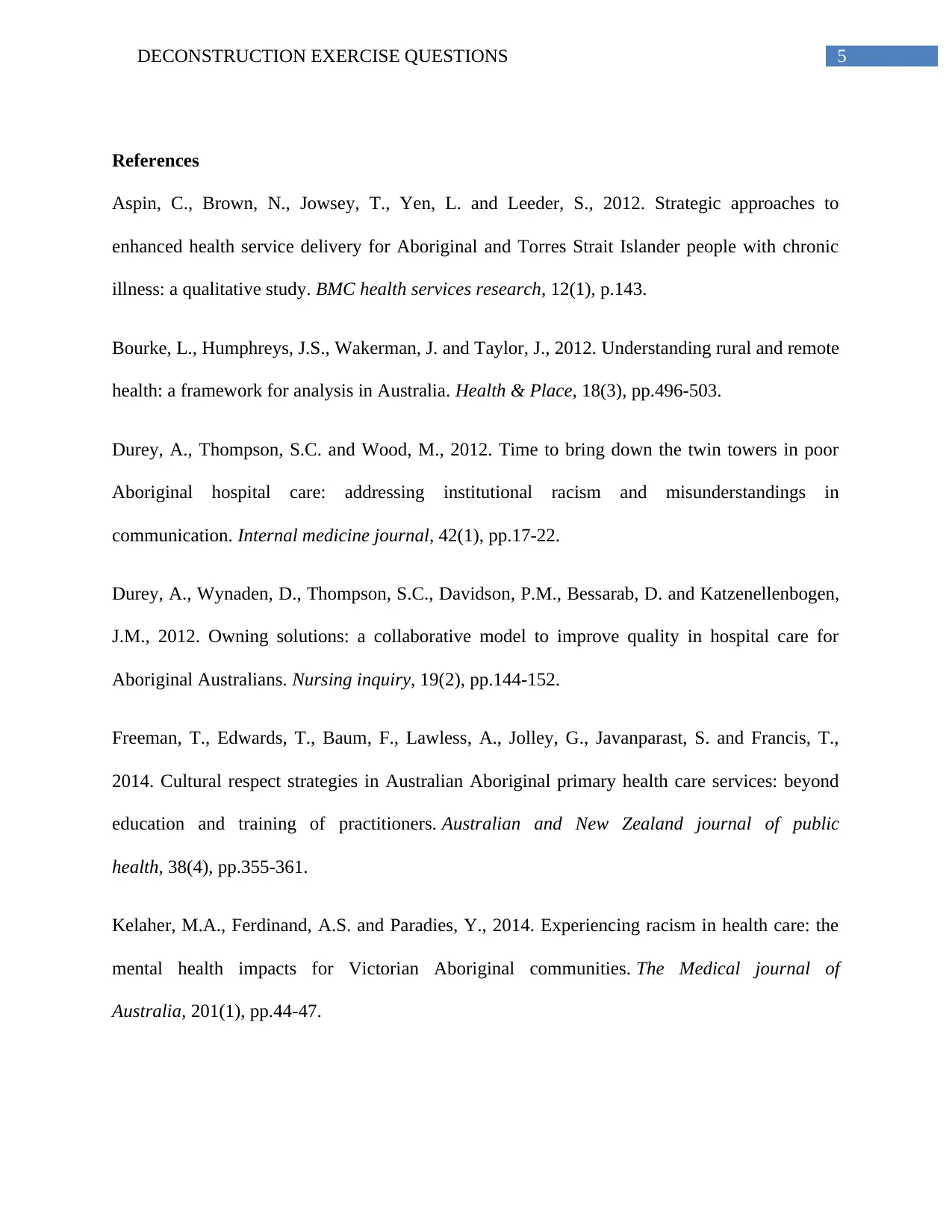
5DECONSTRUCTION EXERCISE QUESTIONS
References
Aspin, C., Brown, N., Jowsey, T., Yen, L. and Leeder, S., 2012. Strategic approaches to
enhanced health service delivery for Aboriginal and Torres Strait Islander people with chronic
illness: a qualitative study. BMC health services research, 12(1), p.143.
Bourke, L., Humphreys, J.S., Wakerman, J. and Taylor, J., 2012. Understanding rural and remote
health: a framework for analysis in Australia. Health & Place, 18(3), pp.496-503.
Durey, A., Thompson, S.C. and Wood, M., 2012. Time to bring down the twin towers in poor
Aboriginal hospital care: addressing institutional racism and misunderstandings in
communication. Internal medicine journal, 42(1), pp.17-22.
Durey, A., Wynaden, D., Thompson, S.C., Davidson, P.M., Bessarab, D. and Katzenellenbogen,
J.M., 2012. Owning solutions: a collaborative model to improve quality in hospital care for
Aboriginal Australians. Nursing inquiry, 19(2), pp.144-152.
Freeman, T., Edwards, T., Baum, F., Lawless, A., Jolley, G., Javanparast, S. and Francis, T.,
2014. Cultural respect strategies in Australian Aboriginal primary health care services: beyond
education and training of practitioners. Australian and New Zealand journal of public
health, 38(4), pp.355-361.
Kelaher, M.A., Ferdinand, A.S. and Paradies, Y., 2014. Experiencing racism in health care: the
mental health impacts for Victorian Aboriginal communities. The Medical journal of
Australia, 201(1), pp.44-47.
References
Aspin, C., Brown, N., Jowsey, T., Yen, L. and Leeder, S., 2012. Strategic approaches to
enhanced health service delivery for Aboriginal and Torres Strait Islander people with chronic
illness: a qualitative study. BMC health services research, 12(1), p.143.
Bourke, L., Humphreys, J.S., Wakerman, J. and Taylor, J., 2012. Understanding rural and remote
health: a framework for analysis in Australia. Health & Place, 18(3), pp.496-503.
Durey, A., Thompson, S.C. and Wood, M., 2012. Time to bring down the twin towers in poor
Aboriginal hospital care: addressing institutional racism and misunderstandings in
communication. Internal medicine journal, 42(1), pp.17-22.
Durey, A., Wynaden, D., Thompson, S.C., Davidson, P.M., Bessarab, D. and Katzenellenbogen,
J.M., 2012. Owning solutions: a collaborative model to improve quality in hospital care for
Aboriginal Australians. Nursing inquiry, 19(2), pp.144-152.
Freeman, T., Edwards, T., Baum, F., Lawless, A., Jolley, G., Javanparast, S. and Francis, T.,
2014. Cultural respect strategies in Australian Aboriginal primary health care services: beyond
education and training of practitioners. Australian and New Zealand journal of public
health, 38(4), pp.355-361.
Kelaher, M.A., Ferdinand, A.S. and Paradies, Y., 2014. Experiencing racism in health care: the
mental health impacts for Victorian Aboriginal communities. The Medical journal of
Australia, 201(1), pp.44-47.
⊘ This is a preview!⊘
Do you want full access?
Subscribe today to unlock all pages.

Trusted by 1+ million students worldwide
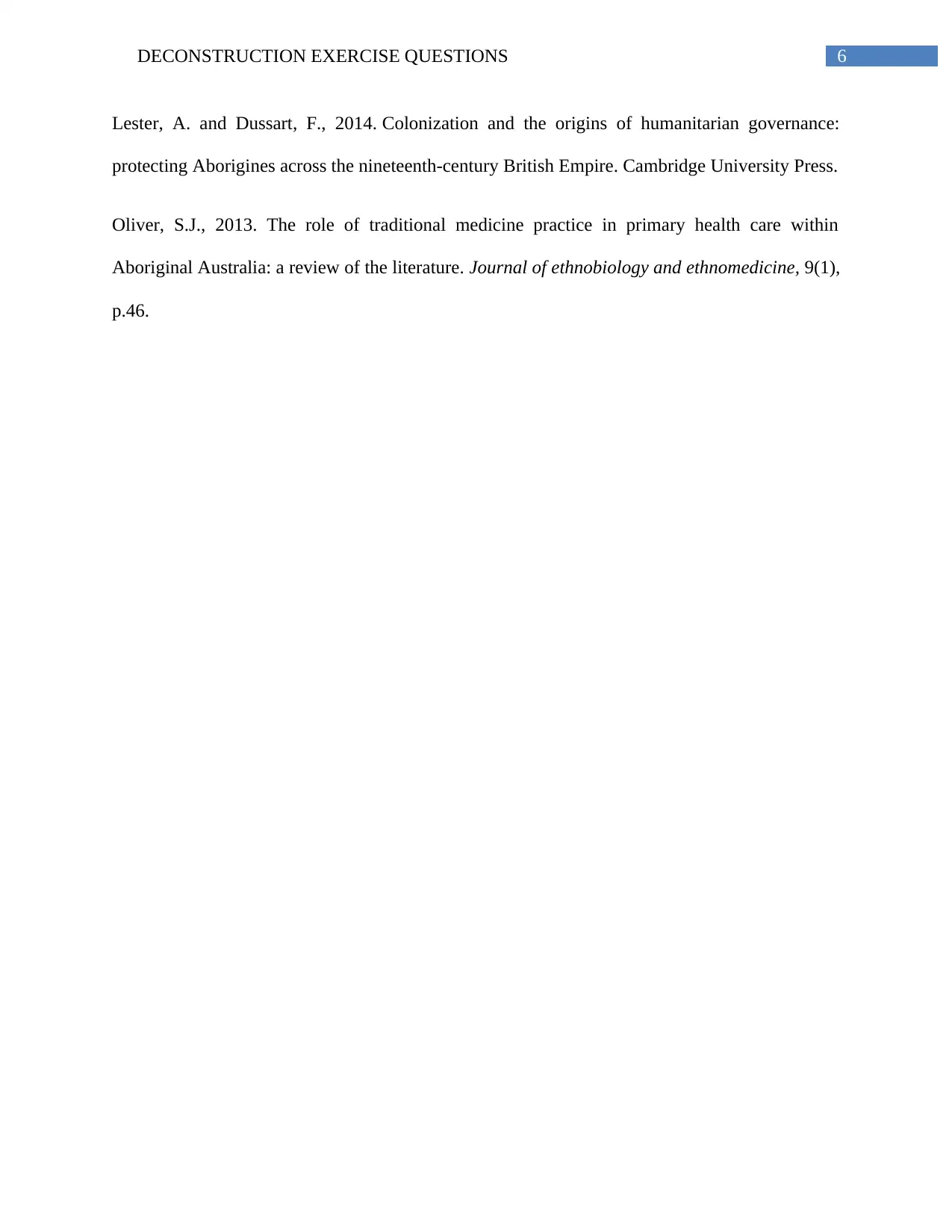
6DECONSTRUCTION EXERCISE QUESTIONS
Lester, A. and Dussart, F., 2014. Colonization and the origins of humanitarian governance:
protecting Aborigines across the nineteenth-century British Empire. Cambridge University Press.
Oliver, S.J., 2013. The role of traditional medicine practice in primary health care within
Aboriginal Australia: a review of the literature. Journal of ethnobiology and ethnomedicine, 9(1),
p.46.
Lester, A. and Dussart, F., 2014. Colonization and the origins of humanitarian governance:
protecting Aborigines across the nineteenth-century British Empire. Cambridge University Press.
Oliver, S.J., 2013. The role of traditional medicine practice in primary health care within
Aboriginal Australia: a review of the literature. Journal of ethnobiology and ethnomedicine, 9(1),
p.46.
1 out of 7
Related Documents
Your All-in-One AI-Powered Toolkit for Academic Success.
+13062052269
info@desklib.com
Available 24*7 on WhatsApp / Email
![[object Object]](/_next/static/media/star-bottom.7253800d.svg)
Unlock your academic potential
Copyright © 2020–2025 A2Z Services. All Rights Reserved. Developed and managed by ZUCOL.




